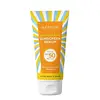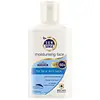What's inside
What's inside
 Key Ingredients
Key Ingredients

 Benefits
Benefits

 Concerns
Concerns

 Ingredients Side-by-side
Ingredients Side-by-side

Water
Skin ConditioningEthylhexyl Methoxycinnamate
UV AbsorberButyl Methoxydibenzoylmethane
UV AbsorberGlycerin
HumectantPropanediol
SolventPolymethyl Methacrylate
Octocrylene
UV AbsorberButylene Glycol
HumectantEctoin
Skin ConditioningAscorbic Acid
AntioxidantHydroxypropyltrimonium Hyaluronate
Hyaluronic Acid
HumectantAcrylates Crosspolymer
AbsorbentAllantoin
Skin ConditioningPhenoxyethanol
PreservativeSodium Acetylated Hyaluronate
HumectantHydrolyzed Hyaluronic Acid
HumectantTocopheryl Acetate
AntioxidantChlorphenesin
AntimicrobialPotassium Hyaluronate
Skin ConditioningSodium Hyaluronate Crosspolymer
HumectantHydrolyzed Sodium Hyaluronate
Skin ConditioningCaprylyl 2-Glyceryl Ascorbate
AntioxidantXanthan Gum
EmulsifyingWater, Ethylhexyl Methoxycinnamate, Butyl Methoxydibenzoylmethane, Glycerin, Propanediol, Polymethyl Methacrylate, Octocrylene, Butylene Glycol, Ectoin, Ascorbic Acid, Hydroxypropyltrimonium Hyaluronate, Hyaluronic Acid, Acrylates Crosspolymer, Allantoin, Phenoxyethanol, Sodium Acetylated Hyaluronate, Hydrolyzed Hyaluronic Acid, Tocopheryl Acetate, Chlorphenesin, Potassium Hyaluronate, Sodium Hyaluronate Crosspolymer, Hydrolyzed Sodium Hyaluronate, Caprylyl 2-Glyceryl Ascorbate, Xanthan Gum
Bis-Ethylhexyloxyphenol Methoxyphenyl Triazine
Skin ConditioningMethylene Bis-Benzotriazolyl Tetramethylbutylphenol
UV FilterEthylhexyl Salicylate
UV AbsorberC12-15 Alkyl Benzoate
AntimicrobialMagnesium Aluminum Silicate
AbsorbentCarbomer
Emulsion StabilisingCitric Acid
BufferingDecyl Glucoside
CleansingDiisopropyl Adipate
EmollientGlycerin
HumectantGlyceryl Stearate
EmollientIsopropyl Palmitate
EmollientNiacinamide
SmoothingPEG-100 Stearate
Potassium Cetyl Phosphate
EmulsifyingPropylene Glycol
HumectantWater
Skin ConditioningMethyl Dihydroxybenzoate
Propylparaben
PreservativeXanthan Gum
EmulsifyingBis-Ethylhexyloxyphenol Methoxyphenyl Triazine, Methylene Bis-Benzotriazolyl Tetramethylbutylphenol, Ethylhexyl Salicylate, C12-15 Alkyl Benzoate, Magnesium Aluminum Silicate, Carbomer, Citric Acid, Decyl Glucoside, Diisopropyl Adipate, Glycerin, Glyceryl Stearate, Isopropyl Palmitate, Niacinamide, PEG-100 Stearate, Potassium Cetyl Phosphate, Propylene Glycol, Water, Methyl Dihydroxybenzoate, Propylparaben, Xanthan Gum
 Reviews
Reviews

Ingredients Explained
These ingredients are found in both products.
Ingredients higher up in an ingredient list are typically present in a larger amount.
Glycerin is already naturally found in your skin. It helps moisturize and protect your skin.
A study from 2016 found glycerin to be more effective as a humectant than AHAs and hyaluronic acid.
As a humectant, it helps the skin stay hydrated by pulling moisture to your skin. The low molecular weight of glycerin allows it to pull moisture into the deeper layers of your skin.
Hydrated skin improves your skin barrier; Your skin barrier helps protect against irritants and bacteria.
Glycerin has also been found to have antimicrobial and antiviral properties. Due to these properties, glycerin is often used in wound and burn treatments.
In cosmetics, glycerin is usually derived from plants such as soybean or palm. However, it can also be sourced from animals, such as tallow or animal fat.
This ingredient is organic, colorless, odorless, and non-toxic.
Glycerin is the name for this ingredient in American English. British English uses Glycerol/Glycerine.
Learn more about GlycerinWater. It's the most common cosmetic ingredient of all. You'll usually see it at the top of ingredient lists, meaning that it makes up the largest part of the product.
So why is it so popular? Water most often acts as a solvent - this means that it helps dissolve other ingredients into the formulation.
You'll also recognize water as that liquid we all need to stay alive. If you see this, drink a glass of water. Stay hydrated!
Learn more about WaterXanthan gum is used as a stabilizer and thickener within cosmetic products. It helps give products a sticky, thick feeling - preventing them from being too runny.
On the technical side of things, xanthan gum is a polysaccharide - a combination consisting of multiple sugar molecules bonded together.
Xanthan gum is a pretty common and great ingredient. It is a natural, non-toxic, non-irritating ingredient that is also commonly used in food products.
Learn more about Xanthan Gum